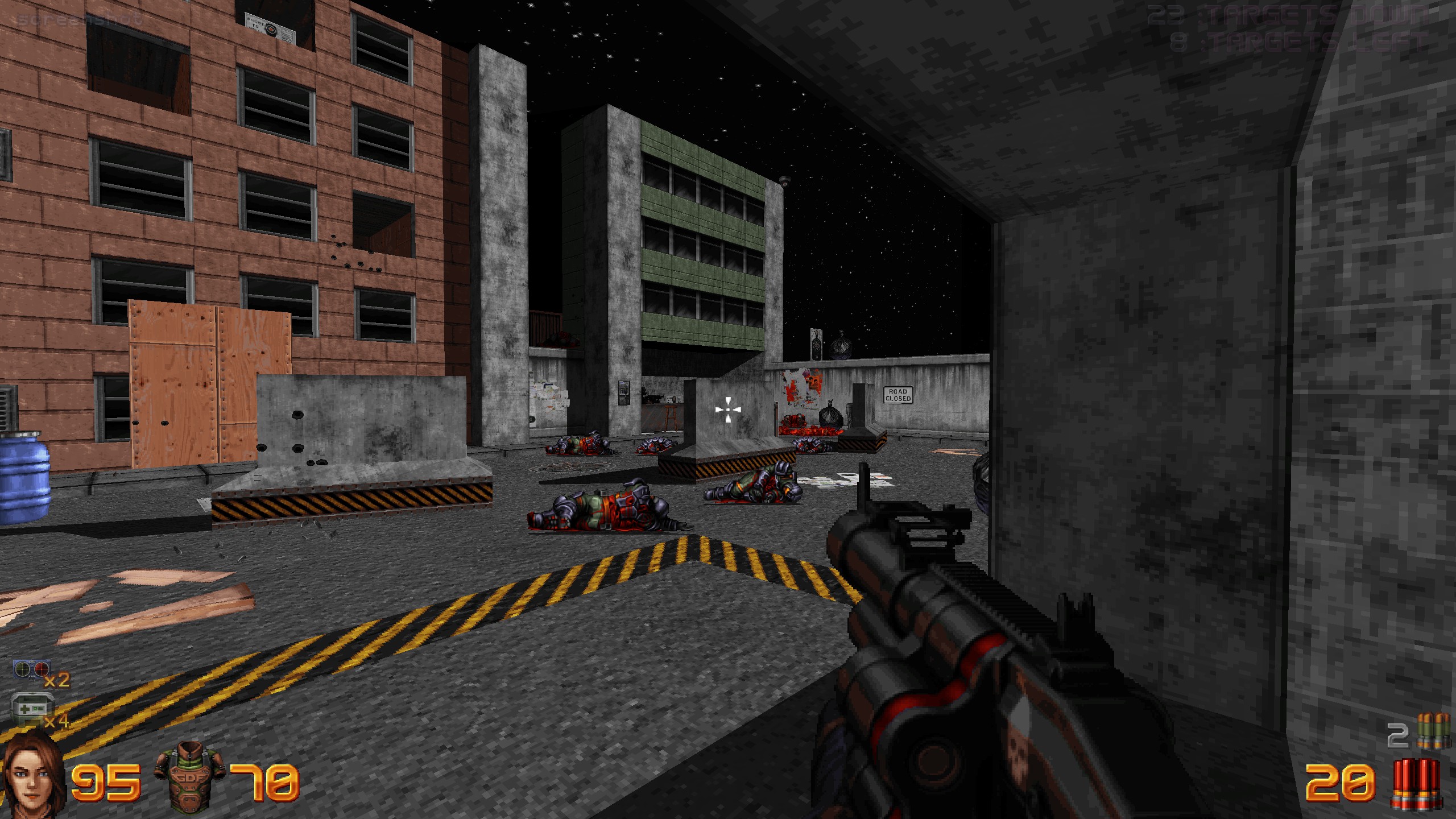Our Verdict
A retro FPS built with love by true enthusiasts of the genre.
PC Gamer's got your back
There are two ways to play a neo-retro shooter like Ion Fury. One: embrace its zippy movement like you're speedrunning a '90s action movie, twitching and snapshotting your way through corridors. Two: meticulously run your eyes and hands along every pixelated surface until you've combed the entire map for secrets.
2019 is tiny renaissance for new FPSes inspired by old FPSes. Where Amid Evil and Dusk conjured the spirit of Quake and Heretic, Ion Fury is published by the company that created Duke Nukem 3D, in a retrofitted version of the original Build Engine. It's the gaming equivalent of a band reuniting for a new album 20 years later.

Ion Fury does recreate many of the things that made Duke Nukem 3D great. An action hero's arsenal. Cheesy one-liners. Bright, expansive environments are dense with enemies and hard-to-spot secret passages. At one point I had to stun an enemy with my electrified baton, crouch-jump onto their skull, and leap to a ledge in order to reach a hidden area.
But as it doubles down on the past, Ion Fury retains some of that era's limitations, too: dead-simple boss behavior, paper-thin storytelling, and a modest feeling of repetition toward the end of its 10-hour campaign. Still, it's potent nostalgia for anyone with affection for or curiosity about '90s FPSes.
VIDEO: A sample of Ion Fury's speedy combat flow, capped off by a minor Easter Egg.
Despite its deep connection to Duke Nukem, Ion Fury's tone is surprisingly different. Supercop heroine Shelly Hamilton (originally written as Duke's sidekick in Duke Nukem Forever) isn't the crass, over-the-top parody that her crew-cutted cousin is. She drops catchphrases, but they aren't crude. The enemies she shoots are similarly serious, an army of cloaked soldiers and a few spooky man-machine hybrids that are miles away from pig cops in a strip club.
You can find weirder weapons in Duke Nukem fan mod Alien Armageddon.
Ion Fury feels a little more like RoboCop Doom—self-aware, but not truly silly—than it does Duke Nukem, then. And while I think that the game's setting is actually one of its best aspects, there were times that I missed the outright stupidity of Duke, particularly in Ion Fury's relatively vanilla weapon set.
You've shot most of these guns before. Generally 3D Realms' approach is to take the genre staples that've sat along your keyboard's number keys for years and plug in little variations on the alt fire button. You can dual-wield the SMGs, which ignite enemies with incendiary ammo. You can spin the chaingun without firing it, like Team Fortress 2's Heavy. You can load the shotgun with shells or pipe grenades, which doesn't so much feel like an exciting alt-fire mode as it does a way of merging two conventional weapons.

The guns are a little too familiar. Given its mad scientist villain and near-future setting, I wanted Ion Fury to put something ridiculous in my hands. The closest the game comes to a bona fide BFG are explosive discs that erupt into a fat cloud of cluster bombs. And there's the Bowling Bomb, a rolling grenade that homes-in on enemies when you charge it up—playful, but a little too fire-and-forget for my liking. It feels good to crack open a door and detonate an entire room with one of these throwables, but you can find weirder weapons in Duke Nukem fan mod Alien Armageddon, which offers rolling turret bots, an ice cannon, and an RPG that lobs miniature nukes. Is it wrong to expect a retro shooter to deliver something new?
Ion Fury feels best when you sprint into danger and then improvise your way out of it.
Other gripes: I don't love how effective the shotgun is at longer ranges because it means I rarely put it down. Auto-aim kicks in occasionally and can't be disabled, a particular annoyance on single-shot guns like the energy crossbow.
The weapons individually underwhelm, but they work well enough as a team. Like most great '90s FPSes, Ion Fury feels best when you sprint into danger and then improvise your way out of it, cycling between five or six guns as you crouch-dodge, circle-strafe, run out of ammo, and lunge for a health kit. Headshots are a welcome modern detail, and the feeling of melting Ion Fury's basic enemy with a single revolver flick doesn't get old. Runner-up: rebounding a pipe grenade off a door frame to frag the cultist waiting inside.

Ion Fury's hand-placed enemies are often waiting to ambush you around corners, and they put up a good fight. Cyborg skulls with spider legs hang on the ceiling ready to jump on you if you don't look up. Legless jetpack monstrosities fling lines of micro rockets at you, filling corridors with splash damage. My favorites were the mobile minibosses which emerge halfway through the game and finally forced me to backpedal. It's crucial to pick a difficulty level that challenges you, as you can't change this setting mid-campaign (although Ion Fury's seven chapters can be launched individually).
But Ion Fury's chapter bosses are less reliable. They certainly check the nostalgia box with their simple scripting and exploitability. At their best, you're jumping around a big room at full speed in order to beat them, emptying every gun you're carrying. At their worst, you're standing still and unloading eight uninterrupted grenades into a cybernetic tank man who's been outsmarted by stairs. 3D Realms' reluctance to bring too much of the present into Ion Fury hurts the game here.

If they Build it, we'll come
Developer Voidpoint's love of the genre is tangible inside Ion Fury's levels. I love the game's color palette, the coat of blue-grey textures and sprites that stay with you as you shoot your way through slightly-futuristic cities and underground labs, walls that are coated with variously easy-to-spot references to Doom, Duke, Half-Life, and other games of the era. The whole world feels like its been marinating in its own juices since 1996, and almost every corner feels hand-crafted. At one point I stumbled into a Hogan's Alley police training course mixed with paper targets and enemies. Behind a bar, I threw Bowling Bombs down a literal bowling alley crawling with cyborg spiders. A couple of dank, muddy sections are the only exception.
True to its retro inspiration, Ion Fury relies almost entirely on colored security keycards to gate progress through these levels. And even truer to those Nukem roots, the other way that Ion Fury opens doors is with explosions (these are so frequent that Shelly eventually remarks in exasperation that every time she touches a button, something blows up). These paths are laid out elegantly. Every level builds in an amount of fun backtracking, and subtle signposting means that you feel smart when you make your way through the maze.

It's worth noting that Ion Fury's Build Engine backbone doesn't present any technical issues. The game supports widescreen resolutions and an FOV range of 70-120, and an fps cap of 240—Ion Fury is one of the rare games that you'll probably be able to hit that ceiling if you're running a variable refresh display. Quicksave and quickload are right there on F6 and F9, but you can limit the number of saves or disable checkpoints for a more spartan experience.
Even alongside other recent, excellent retro FPSes, Ion Fury reminds us of how much this period of PC gaming has to offer. It's surely the best thing that's ever happened in the Build Engine, and although limitations of enemy and weapon design reveal themselves over time, the swift movement and sleek maps make Ion Fury a worthy indulgence in the past.
A retro FPS built with love by true enthusiasts of the genre.

Evan's a hardcore FPS enthusiast who joined PC Gamer in 2008. After an era spent publishing reviews, news, and cover features, he now oversees editorial operations for PC Gamer worldwide, including setting policy, training, and editing stories written by the wider team. His most-played FPSes are CS:GO, Team Fortress 2, Team Fortress Classic, Rainbow Six Siege, and Arma 2. His first multiplayer FPS was Quake 2, played on serial LAN in his uncle's basement, the ideal conditions for instilling a lifelong fondness for fragging. Evan also leads production of the PC Gaming Show, the annual E3 showcase event dedicated to PC gaming.


